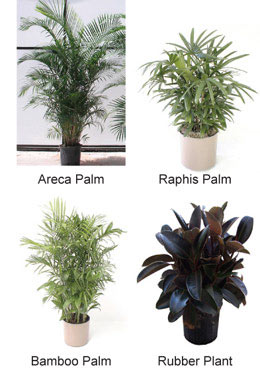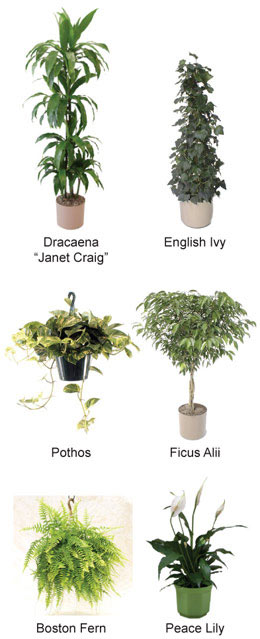 Submitted by Shades Of Pale on
Submitted by Shades Of Pale on

Did you know that the air quality indoors, even in a new and clean building, is considered dangerously polluted by widely accepted air quality standards? Unless you live in a cutting edge, LEED Platinum house with excellent ventilation, it is highly likely that you are breathing in all kinds of toxic particulates and gases that are silently and constantly being generated by the synthetic chemicals in your home and the various materials it is made from (carpet, paint, wood finishing, TV’s, electronics, etc.). Many people are aware of this and buy machines to purify the air in their home or office. These are a step in the right direction, but nothing is quite as powerful or effective as nature. We highly recommend the use of plants that are known for removing toxins and generating abundant oxygen. Unlike machines, plants are totally natural and are biologically aligned with the needs of the human body, making them the perfect remedy for indoor air quality. Below you will find a list of 10 excellent plants for this purpose. Best of all, they are cheap, readily available and easy to maintain.
By Dr. Akilah El
http://www.thehealersjournal.com/2013/05/28/10-plants-clean-and-purify-the-air-inside-your-home

Areca Palm
Also known as yellow palm or butterfly palm, the areca palm is one of the most popular and graceful palms. It is tolerant of the indoor environment, releases copious amounts of moisture into the air, removes chemical toxins, and is beautiful. The areca is consistently rated among the best houseplants for removing all indoor air toxins tested. Best in direct, bright sunlight.
Raphis Palm
This large palm has fans six to 12 inch wide with four and 10 thick, shiny leaves. It is highly resistant to attack by most plant insects and is great for improving indoor air quality. It grows slowly and is easy to maintain. Best in direct, bright sunlight.
Bamboo Palm
Easy to care for and a popular variety. The bamboo palm pumps much needed moisture into the indoor atmosphere, especially during winter months when heating systems dry the air. This palm is also one of the top-rated plants tested for the removal of benzene, trichloroethylene and formaldehyde. Best in direct, bright sunlight.
Rubber Plant
Bred for toughness, it will tolerate dim light and cool temperatures, making it an excellent house plant. This plant is easy to grow and is great for removing chemical toxins from the indoor environment, particularly formaldehyde. Best in direct, bright sunlight to indirect, medium sunlight.

Dracaena “Janet Craig”
The dark-green leaves of dracaena “Janet Craig” make it an attractive plant. It is one of the best plants for removing trichloreoethylene. These plants can tolerate neglect and dimly lit environments. This plant does best in indirect, medium sunlight. It will tolerate dimly lit areas, but growth will be slow.
English Ivy
English Ivy is often used as ground cover in public atriums or lobbies. But to add interest, try growing it in topiary form or in hanging baskets. They are easy to grow and adapt to a variety of home environments. However, they do not generally do well in high temperatures. Best in indirect, medium sunlight to low sunlight.
Pothos
One of the primary reasons Pothos is popular is it can tolerate lower light, lower humidity and cooler temperatures than many other plants. Pothos are rated one of the best houseplants for removing all indoor air toxins. Pothos also goes by a few other names: devil’s ivy, pothos ivy and has a few cultivars. The most common variety “Golden Pothos” gets the most use in the interior business. Two other varieties are “Marble Queen” with a streaky white on green and “Jade” which is green. Pothos does not like wet feet and the soil should not stay too moist. Every so often a Pothos could use a good pruning – but prune selectively. This will also promote new growth. Best in indirect, medium sunlight but it will also tolerate very low light.
Ficus Alii
This is a new ficus variety that is rapidly gaining in popularity. Its slender dark green leaves make it an extremely attractive plant. Its ability to help purify the air, ease of growth and resistance to insects make it an excellent choice for the home or office. It is much less finicky than the Ficus Benjamina. Like all species of ficus, expect some leaf drop until the plant adjusts to its new location. Best in direct, bright sunlight to indirect, medium sunlight.
Boston Fern
Ferns are probably one of the oldest groups of plants. Many have been found as fossils dating back to prehistoric times. The Boston Fern’s stiff fronds arch out, drooping downward as they age. It is grown strictly for its foliage for it does not produce flowers. It is best displayed in a hanging basket or sitting upon a pedestal. As an indoor plant, the Boston Fern requires a certain amount of attention. It must have frequent misting and watering, or the leaves will quickly turn brown and begin to drop. It is the best for removing air pollutants, especially formaldehyde, and for adding humidity to the indoor environment. Best in indirect, medium sunlight.
Peace Lily (Spathiphyllum)
An outstanding foliage plant that also produces beautiful white spathes, the peace lily should always be included when seeking a variety of indoor plants. This plant has a high transpiration rate and enjoys the large water reservoir that hydroculture offers. It possesses all the qualities to make it one of the best indoor plants. The Peace Lily excels in the removal of alcohols, acetone, trichloroethylene, benzene and formaldehyde. Its ability to remove air pollutants and its excellent performance in all categories make it a most valuable houseplant. Best in indirect, medium sunlight to low sunlight.
The Healers Journal © 2014 All Rights Reserved
The Healers Journal © 2014 All Rights Reserved
- 1017 reads